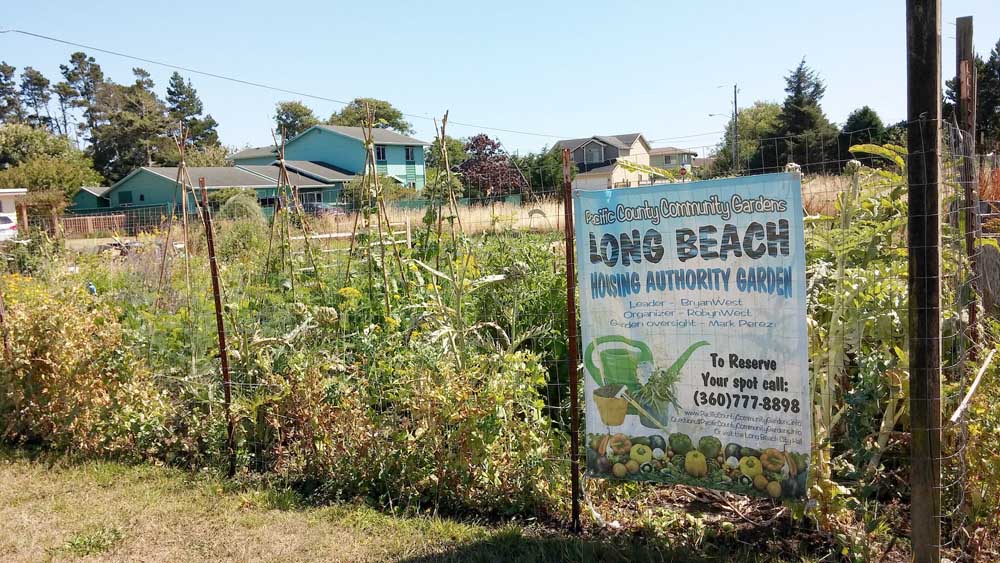Garden Mind Community Gardens, Part II: Increasing access to fresh food
Published 9:16 am Tuesday, August 18, 2015

- This is the community garden in Long Beach, for local use by nearby residents.
“Give a man a fish and you feed him for a day; teach a man to fish and you feed him for a lifetime.”
Trending
— Maimonides or Confucius or Lao Tsu or Plato…
And the same can be said for gardens and the growing of food.
In my last column I shared ideas about getting a community garden off to a start, and presented a doable list of important items to consider before attempting this endeavor.
Trending
It’s funny, for me to have this passion for community access to resources to grow your own food, because I own my own place, and I don’t need a community space. And in fact, I use the garden as a contemplative practice, but I believe people must have access to gardens and the opportunity to get their hands in the soil. That as much as access to the fresh food.
Bellwethers
I’ve heard some say this dry year is the bellwether of climate change, yet others pooh-pooh and suggest the climate is always different and therefore it’s always changing.
Ahem, those are not the same thing, and only a long look back — after a few years pass! — will light up that crystal ball.
My plant interests are primarily about landscape and ornamentals. To me, plants are plants, whether you sniff them, admire them, climb them, burn them, or eat them; once a plant enthusiast masters one genus or plant family it’s easy to consider inter-relating with the rest. Plants become a gateway to greater global awareness.
Why do I care about community gardens? Why do I ask about the local politics around access to growing food? Who cares if people who want to grow their own food can’t, if they don’t have land, or they don’t have the experience? Who cares and is it the responsibility of anyone to care?
In an effort to understand the underlying dynamics around the local garden politics, I go to my on-line reference for a perspective on our home, Pacific County. Here, at the bottom southwest corner of the state, we sit, comprised of 1,223 square miles, of which 233 are water and 933 square miles land. Divided into north and south county, with the Long Beach peninsula at the south end and Raymond and South Bend at the northern part. There are four cities and seven other “census designated areas.”
The county population is reckoned at about 20,500, with a per capita income of $17,322, according to 2010 census findings. About 9 percent of families and 14.4 percent of total population were below the poverty line. Age distribution is 21.4 percent under 18, 6 percent 18-24, 21.2 percent from 25-44, 28.9 percent from 45 to 64, and 22.6 percent 65 or older. Thirty-three percent are in single-person homes. The per capita income is about $17,322.
Looking at these public census figures, we have a population of 27.4 percent under age 24, and 22.6 percent over age 65; this is 50 percent of the population, under or not gainfully employed.
In most communities, housing and food are a household’s largest budgetary expenses. It’s clear an enormous need exists for more community access to food. Does it seem that way to you?
Next column I’ll interview some agencies involved in food delivery. In other areas, community gardens and urban farming are proven contemporary solutions to the food and poverty problem; perhaps the same solutions can be applied here, as well.
I recently spoke to a few locals to get a sense of the roles of some agencies and groups. One group is the Master Gardeners, a statewide research university-based volunteer organization, designed to create an informed resource for communities to disseminate information about gardening and horticultural practices. They are affiliated with the county Extension service. Across the Columbia River, in Astoria, Master Gardener training is offered annually; in Pacific County it’s offered every two years, and not always in south county. As part of the “pay back” for the training, MG volunteers do communities service projects; one of the major projects in south county is maintaining the demonstration garden outside the Columbia-Pacific Heritage Museum in Ilwaco. Members also keep a booth at the Ilwaco Saturday Market.
Local interest in community gardens in schools has waxed and waned, and I talked to one local informed woman about changes over the past 10 years in a school garden project, and thought on what can be done to re-establish these gardens locally.
At this time there is one community garden in Long Beach, for residents of a community housing enclave, and that is it for south county.
If you have no land you can’t easily raise food. There is plenty of land here, at 22 people per square mile. Remember, 50 percent of our population gets by on unearned income. What do people eat? Do they want a different diet? And where do they get fresh foods?
Another challenge to growing fresh food goes back to our opening quote, borrowed by countless cultures: How do we teach people what their grandparents and great grandparents knew (seemingly by direct transmission). Fifty years ago almost everyone had at least a small family garden, some had a few chickens, too. Most elders had knowledge of growing and preserving foods. These skill sets must become re-established if we wish to be a country of self-reliant and healthy people in the years to come.
Whose of us with knowledge have to create pathways to teach. Then, people learn to husband plants and animal protein sources, and restrictions can be eased for individuals and families to engage in these practical pursuits. The towns of Long Beach and Ilwaco and South Bend-Raymond are tiny pockets of under-populated towns, but still are where most of the populations are concentrated. We need some type of community action to make this happen locally.
Urban farming belongs here, among us all, and people need to be encouraged to take on the practices that build health and the well being of families.
Coming: Community Gardens, Part III; Interviews and back story, and moving ahead.






